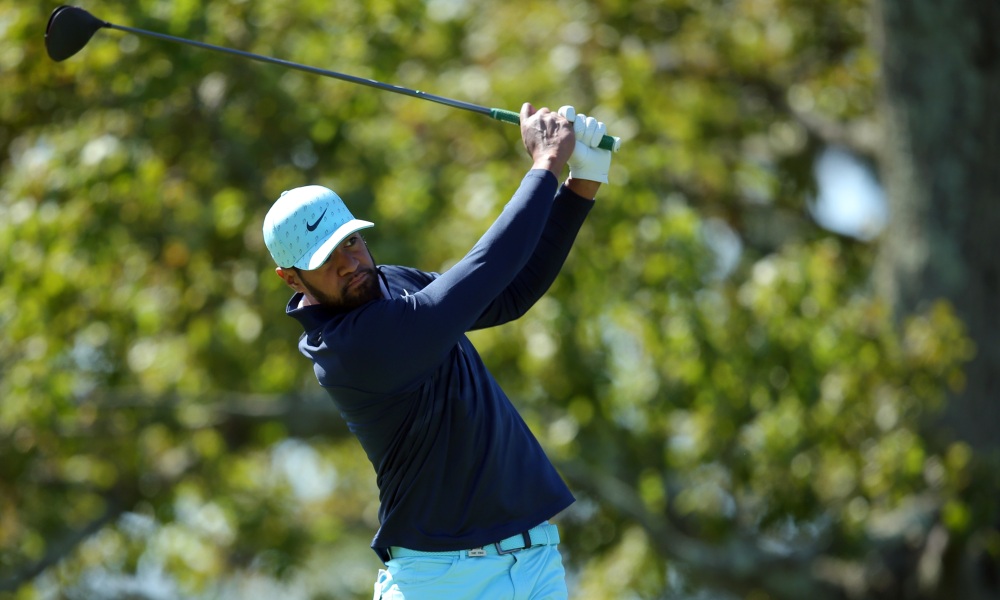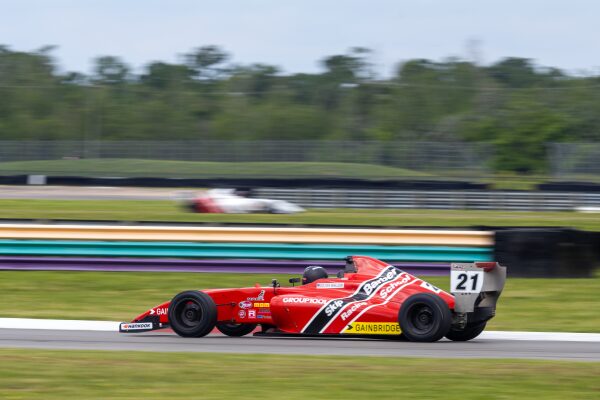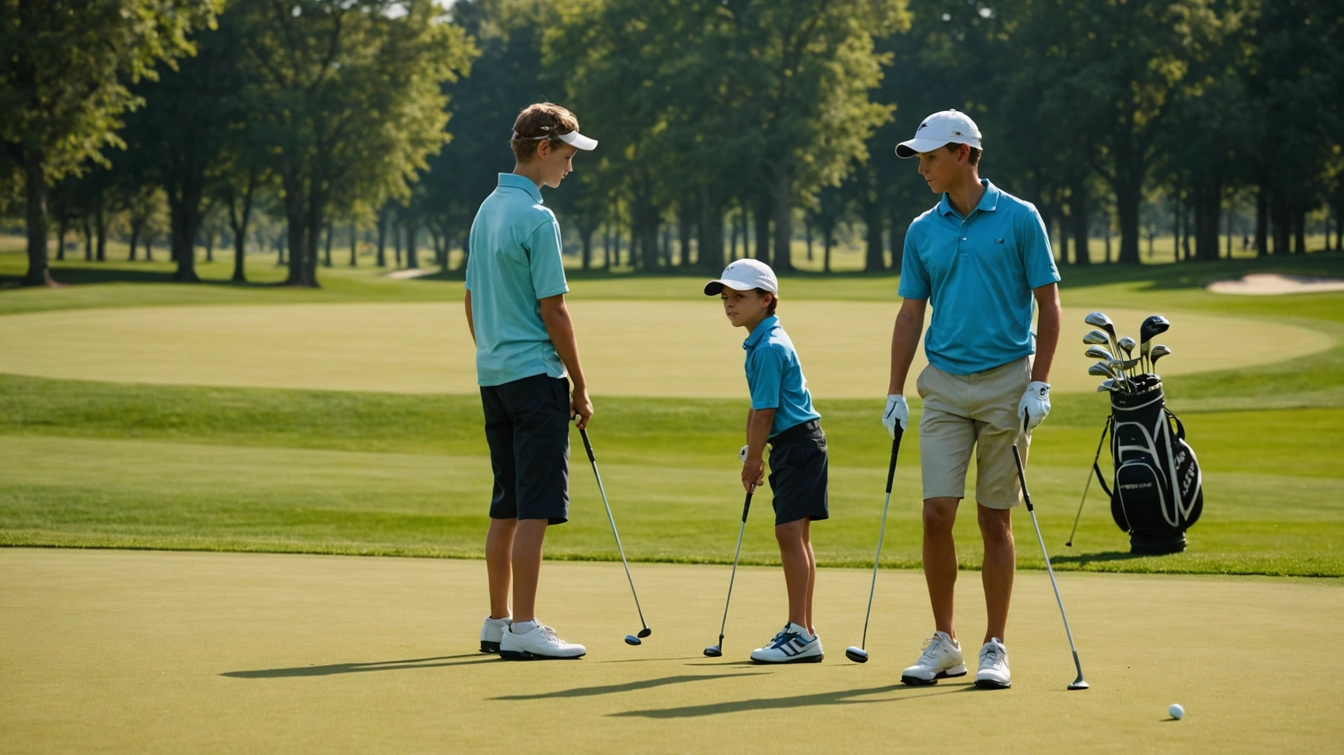Blog
Tony Finau’s Rarely Used Secret Weapon

The relationship between distance and ball speed can vary slightly, but it’s safe to assume that every mile per hour increase in ball speed will net roughly 2 yards of additional carry. Taking those numbers into account, Tony Finau is leaving roughly 52 yards in the tank whenever he tees it up on the PGA Tour.
If math wasn’t your strength in school — join the club — that comes out to 26 mph of ball speed. Ball speed. It’s a number that sounds absolutely preposterous, especially when you consider Finau ranked 28th on Tour last season in ball speed at 177.91 mph. Compared to ball speed leader Cameron Champ (190.94 mph), he’s more than 13 yards off the pace.
While the ball speed average only takes into account valid radar measurements on par 4s and par 5s, it’s safe to say Finau is fast — but he isn’t that fast. Or at least that’s what the numbers say.
According to Ping Tour rep Kenton Oates, Finau has a gear that he rarely if ever shows in competition. While speaking to GOLF’s Fully Equipped podcast, Oates recalled a recent conversation with Finau at the Houston Open about a speed training session he’d gone through recently that netted him a ball speed number few on the planet can produce.
“I was talking with him on the range [in Houston] and he was hitting a [Ping G425 LST] with 180 mph ball speed,” said Oates. “Then he tells me he was at a speed training session in Utah and got 206 mph ball speed on his 12th ball. It’s insane.
“When he told me he hit 206, I told him, you’re the only guy on tour who leaves 26 mph out there.”
During an interview last year with GOLF’s Subpar, Finau revealed he’d bet on himself in a long drive contest against the likes of Champ, Bryson DeChambeau and Rory McIlroy.
“I do think if you just get us on a driving range and give each of us five golf balls and see who can get it the furthest, I’d have a hard time believing someone can get it further than me,” Finau said.
Of course, the Tour isn’t a long drive contest, and Finau is realistic about what it takes to win at the top rung of professional golf. While distance can give you an edge over the competition — look at Bryson’s incredible transformation — losing accuracy and gaining ball speed in the process feels like a zero-sum game.
“I think the reason he continues to stay at 180 to 185 is that he’s so straight off the tee,” Oates said. “Tony’s always been long. I’ve heard stories of him being even longer as a kid — like 215s in ball speed. For him, he became a really good player when he honed it in. In the back of his mind, he knows if he’s at 180 to 185 and only curving it 2 yards, he’s going to be a really, really good player.
“He doesn’t hit it that far offline [at the higher speeds] compared to a normal golfer, but it’s different in PGA Tour terms.”
As one of the most consistent (and longest) drivers of the golf ball on Tour, Tony Finau isn’t hurting for an edge. But if he ever needs to unleash a gargantuan drive, at least he knows he has it in the tank — and then some.
This article originally appeared on Golf.com.
Blog
Golf Course Aesthetics: Exploring the Artistry of Manicured Landscapes
Imagine standing at the tee of a beautifully manicured golf course, gazing out across a landscape of rolling greens, sculpted bunkers, and artfully placed bodies of water.

The Intersection of Golf and Art: Viewing Golf Courses as Living Masterpieces
Imagine standing at the tee of a beautifully manicured golf course, gazing out across a landscape of rolling greens, sculpted bunkers, and artfully placed bodies of water. The course stretches out before you like a canvas, a living masterpiece of design and nature. This is where golf and art intersect, where the game becomes more than just a sport and the course becomes more than just a playing field. It is a crossroads where the beauty of nature and the aesthetics of design come together to create a truly unique experience.
Understanding Golf Courses as Works of Art
Golf courses are meticulously designed and maintained, with every element placed with purpose and intention. They are the result of careful planning, creative vision, and a deep understanding of both the game of golf and the principles of landscape design. In this way, they can be viewed as works of art, with the designer acting as the artist and the landscape serving as the canvas.
The Aesthetics of Golf Course Design
Golf course design is a subtle blend of art and science. Designers must consider a range of factors, including the natural features of the landscape, the skills and abilities of the players, and the overall aesthetic of the course.
Key elements of golf course design include:
- Landscape: The natural features of the landscape, including trees, water bodies, and elevation changes, are integral to the design of a golf course.
- Layout: The layout of a golf course is carefully planned to provide a balance of challenge and enjoyment for players.
- Hazards: Hazards, such as bunkers and water bodies, are strategically placed to add challenge and visual interest to the course.
- Green Complexes: These are the areas surrounding the putting surfaces. They include elements such as bunkers, mounds, and grassy hollows, all of which contribute to the aesthetic appeal and challenge of the course.
The Artistic Influence on Golf Courses
Many renowned golf course designers approach their work with an artist’s eye. They view the landscape as a blank canvas, using the natural features of the land and the principles of design to create an aesthetically pleasing and challenging course.
One of the most influential golf course designers, Alister MacKenzie, was actually a trained surgeon before he turned his hand to course design. His medical background gave him a unique perspective on the relationship between the human body and the landscape, and he used this knowledge to create courses that were both beautiful and challenging to play.
In his book, “The Spirit of St. Andrews,” MacKenzie wrote, “A golf course should be a beautiful place, so arranged that it pleases the eye and stimulates the mind, while the game itself brings the muscles into play.” This philosophy is evident in his designs, which are renowned for their natural beauty and strategic complexity.
Golf Course Design and Environmental Art
In recent years, there has been a growing recognition of golf course design as a form of environmental art. This is due to the increasing focus on sustainability and environmental conservation in the design and maintenance of golf courses.
An excellent example of this is the work of Bill Coore and Ben Crenshaw, who are known for their minimalist approach to course design. Their courses are designed to fit seamlessly into the natural landscape, with minimal alteration of the land. They use the existing topography and vegetation to create a course that is both challenging and visually stunning.
The Future of Golf Course Design
As we look to the future, the intersection of golf and art is set to become even more pronounced. With advances in technology, designers have increasingly sophisticated tools at their disposal, allowing for even greater creativity and innovation in course design.
At the same time, there is a growing emphasis on sustainability and environmental stewardship, with designers striving to create courses that are not only beautiful and challenging to play, but also in harmony with the natural environment.
In conclusion, golf courses are far more than just playing fields for a game. They are living canvases, where the artistry of design meets the beauty of nature. Whether you’re a golfer or not, the next time you step foot on a golf course, take a moment to appreciate the artistry and design that has gone into creating that space. It’s a testament to the incredible intersection of golf and art, and a reminder that sometimes, the crossroads of different worlds can create something truly beautiful.
Blog
When Golf Meets Supercars: The World Series of Golf Takes Over Skip Barber’s Mexico Resort
World Series of Golf partners with Skip Barber Racing for a two-year luxury sports series at Gran Reserva, Mexico – where championship golf meets supercars starting April 2026.

Picture this. You’re standing on the 18th green at Gran Reserva, Mexico, finishing a round of championship golf with the World Series of Golf’s signature betting format still buzzing in your veins. The sun’s dropping low. Your heart’s still racing from that final putt.
And tomorrow? You’re driving a McLaren on Skip Barber’s brand-new racetrack.
Two Sports, One Unforgettable Weekend
The World Series of Golf just announced something we’ve never seen before. A two-year partnership with Skip Barber Racing School that transforms their new Mexican resort into the ultimate luxury sports destination. It’s not just golf. It’s not just racing. It’s both, wrapped into an experience that redefines what a sporting weekend can be.
Starting in April 2026, Gran Reserva becomes ground zero for a completely new kind of event.
Year One: The Foundation
The first year lays the groundwork. You’ll compete in the World Series of Golf championship using their patented tournament format – the one that adds poker-style betting mechanics to traditional stroke play and turns every hole into a strategic showdown. High stakes. Real tension. Golf the way it was meant to be played.
But here’s where it gets interesting. While you’re playing, Skip Barber’s building their racetrack right there on the property. You’ll see construction crews working on what will become one of North America’s most anticipated racing circuits. State-of-the-art simulators give you a taste of what’s coming, letting you experience the thrill of motorsports between rounds.
VIP receptions. Celebrity appearances. Curated culinary showcases that match the caliber of the competition. It’s an invitation-only event designed for people who expect excellence and aren’t willing to settle for anything less.
Year Two: The Payoff
Then 2027 hits. The track is finished. And suddenly you’re not just imagining what it’s like to drive a supercar at speed – you’re actually doing it.
McLaren. Ferrari. Mercedes. Lamborghini. Take your pick and put it through its paces on a circuit designed by people who’ve spent over 50 years teaching professional racers how to extract every ounce of performance from a machine. Skip Barber doesn’t mess around when it comes to motorsports education, and this track reflects that pedigree.

You’ll stay in exclusive luxury accommodations at Gran Reserva, network with athletes and industry leaders, and experience both golf and racing at the highest possible level. All in one place. All in one unforgettable weekend.
Why This Matters
Michael Berg, CFO of Skip Barber Racing School, called it perfectly: “Guests will see the racetrack under construction during our first event and then drive world-class vehicles on it the following year.”
That’s the hook. You’re not just attending an event. You’re watching it evolve. You’re part of the story from day one, and by year two, you’re living the payoff.
Robert Davidman, CEO of the World Series of Golf, added this: “This partnership unites golf and motorsports in an elevated format that caters to international fans seeking competition, luxury, and adventure.”
Competition. Luxury. Adventure. Three words that sum up what makes this special.
Why Sponsors Are Paying Attention
Here’s what makes this different from every other golf tournament trying to get your marketing dollars.
The World Series of Golf’s patent-protected format keeps spectators glued to every shot. Shot-by-shot wagering. Antes that double every three holes. Strategic decisions that matter as much as swing mechanics. It’s golf designed for television, and television designed to keep people watching.
Add Skip Barber Racing to the mix and you’ve got something networks actually want to cover. Over 40 hours of TV coverage. More than 15 million media impressions. Five million-plus social media reach. This isn’t a local tournament hoping for some local news pickup. This is a broadcast-ready event with an audience that’s already paying attention.
The demographics tell the rest of the story. You’re reaching affluent golf enthusiasts who also appreciate high-performance automobiles. International travelers who think nothing of flying to Mexico for a weekend of luxury sports. Decision-makers and industry leaders who network at VIP receptions and actually have the authority to sign deals on the spot.
Title sponsorship gets you naming rights, eight playing positions, and premium TV exposure throughout the broadcast. But even smaller packages deliver value. Hole sponsors get exclusive on-course branding and social media mentions for ten grand. Golf cart wraps guarantee TV and photo exposure because every shot of the tournament includes your brand.
The opportunities are limited by design. Only 18 hole sponsors. Three presenting sponsors. One title sponsor. Once they’re gone, they’re gone.
Want the details? Check out the full sponsorship packages at wsg.golf/sponsorship.
The Bottom Line
This isn’t your typical golf tournament. It’s not your standard track day either. It’s something entirely new – a two-year luxury sports series that gives you the best of both worlds and raises the bar for what a sporting experience can deliver.
Year one plants the seed. Year two delivers the harvest. And whether you’re attending as a player or partnering as a sponsor, you’ll be there for both.
For player inquiries, contact events@skipbarber.com. For sponsorship opportunities, reach out to sponsorship@wsg.golf. These events are strictly invitation-only, and opportunities won’t last long.
Golf and supercars. Mexico and motorsports. The World Series of Golf and Skip Barber Racing School.
This is going to be something special.
Blog
Empowering the Next Generation: The Impact of Youth Golf Programs on Shaping Future Golfing Stars
As we tee off into the 21st century, golf, the age-old sport of precision and patience, is witnessing a remarkable transformation.

The Rise of Youth Programs: Unleashing the Potential of Next-Gen Golfers
As we tee off into the 21st century, golf, the age-old sport of precision and patience, is witnessing a remarkable transformation. The sport, once considered a domain of the mature and affluent, is now attracting a younger demographic like never before. The driving force behind this shift? The rise of youth golf programs.
These youth-oriented initiatives are not only making golf more accessible to younger generations but are also nurturing the next wave of golf superstars. So, grab your clubs, and let’s explore how these programs are changing the face of golf and paving the way for next-gen golfers to take center stage.

The Emergence of Youth Golf Programs
In the past, golf was often perceived as a sport for the elite, with limited opportunities for young players to learn and develop their skills. However, the landscape has dramatically changed in recent years, thanks to the emergence of youth golf programs.
These programs are designed to introduce children and teenagers to the sport, provide them with necessary training, and help them develop their skills. From local clubs offering golf lessons for kids to national organizations like The First Tee and PGA Junior League, these initiatives are making golf more accessible to younger generations.

The Impact of Youth Programs on the Golf Industry
Youth golf programs have had a profound impact on the golf industry, contributing to its growth and diversification. Here’s how:
- Increasing Participation: Youth programs have significantly boosted golf participation rates among young people. According to the National Golf Foundation, more than 2.5 million kids aged 6-17 played golf on a course in 2019, a 20% increase from 2011.
- Creating Diversity: Youth programs are also making golf more diverse. They are reaching out to children from different socio-economic backgrounds, providing them with opportunities to learn and play golf.
- Developing Talent: These programs are proving to be a breeding ground for future professionals. Young golfers like Jordan Spieth, Rickie Fowler, and Lexi Thompson, who were part of youth programs, have gone on to make their mark in the professional arena.
- Skill Development: These programs provide kids with comprehensive golf training, helping them develop technical skills like swing mechanics, putting, chipping, and bunker play. They also focus on strategic aspects like course management and decision making.
- Character Building: Golf is not just about technique; it’s also about character. Youth programs emphasize life skills such as honesty, integrity, sportsmanship, and perseverance – values that are integral to golf and life in general.
- Competitive Exposure: Youth programs also provide young golfers with competitive exposure through tournaments and leagues. This exposure helps them understand the competitive nature of the sport, learn to handle pressure, and develop a winning mentality.

How Youth Programs are Nurturing Next-Gen Golfers
Youth golf programs are making significant strides in nurturing the next generation of golfers. Here’s how:

The Bright Future of Youth Golf
The rise of youth golf programs has set the stage for a promising future. As more and more young people take up the sport, we can expect to see a new generation of golfers who are not only technically sound but also carry the values and spirit of the game.
Moreover, the increasing participation of young golfers is likely to infuse fresh energy and excitement into the sport, making it more appealing to spectators and sponsors alike.
In conclusion, the rise of youth golf programs is a game-changer. It’s not just about creating a new generation of golfers; it’s about shaping the future of golf itself. So, whether you’re a parent, a young golfer, or a golf enthusiast, it’s time to embrace these programs and support the next generation in their journey towards golfing excellence.
-

 Product Review6 years ago
Product Review6 years agoThe Perfect Practice Putting Mat Review by Jason Tenzer
-

 Blog4 years ago
Blog4 years agoLoophole Rule Offers PGA Tour Pros a Mulligan
-

 Blog4 years ago
Blog4 years ago2021 Buyer’s Guide: The Top 10 Value Golf Balls For Distance & Feel
-

 Blog4 years ago
Blog4 years agoGolf Marriage Counselor
-

 Blog6 years ago
Blog6 years ago9 Biggest Chokes Of The Past Decade
-

 Product Review6 years ago
Product Review6 years agoTHE ADJUSTABLE IRONS: WALKING STICKS GOLF CLUBS
-

 Blog4 years ago
Blog4 years agoWhat Your Golf Clubs Say About You
-

 Equipment6 years ago
Equipment6 years agoOHK Sports Interview by Jason Tenzer


















